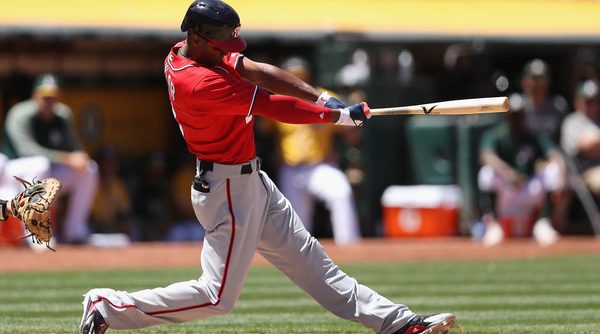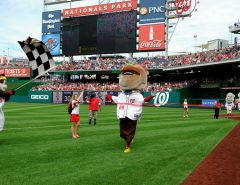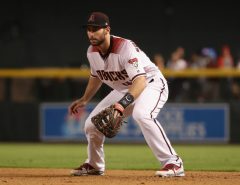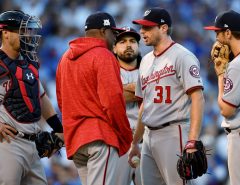Today is the NHL’s expansion draft. If you’re unfamiliar, here’s a quick primer of the NHL expansion rules: each team is allowed to select a certain number of its players to protect. Any others are eligible to be selected by the expansion team, which must select exactly one player from each team.
So, in the spirit of keeping things topical, I decided to take a crack at seeing who the Nationals would protect in an expansion draft. MLB had its own expansion draft 20 years ago when the Arizona Diamondbacks and Tampa Bay Devil Rays joined, and therefore has its own set of rules.
- Each team can protect 15 total players from its organization — majors or minors.
- Some players don’t have to be protected: Players chosen in the 1996 or 1997 amateur drafts, or players who were 18 or younger when they were signed in 1995.
- Each team will chose 35 players, and since there are two new teams, the draft has three rounds.
- Like the NHL, each team can only lose one player per round. Since the third round will only have 10 picks, not every team will lose three players.
- After each round, every team can protect 3 additional players.
- We’ll say this draft takes place at the end of the 2017 season, so impending free agents like Jayson Werth won’t be protected. We’ll assume Matt Wieters opts out of his deal as well.
First off, we need to figure out which Nats don’t need to be protected. Fortunately for the Nationals, those restrictions automatically protect quite a few of their best prospects.
Since we’re doing our draft at the end of the 2017 season, players from the 2017 and 2016 drafts are protected, plus players who signed at 18 or younger in 2015. That protects a pretty impressive list of guys. Some notables: Seth Romero and Wil Crowe from this year’s draft; Carter Kieboom, Sheldon Neuse, and Jesus Luzardo from last year’s; Juan Soto as a 2015 international signee; and Blake Perkins and Tyler Watson as 18-year-olds chosen in the 2015 draft. That’s two of the Nats’ top four prospects in Soto and Kieboom — three of their top five if you think (like I do) that Romero will enter the system’s top five when he signs. Crowe, Neuse, Luzardo, Perkins, and Watson are also top-20 prospects.
The rules don’t explicitly say this, but I assume that since players signed in 2015 at 18 or younger are ineligible, players of a similar age signed in 2016 or 2017 are also ineligible. That would protect all the players in the Nationals’ big 2016 international spending class, including top-10 prospect Luis Garcia and top-25 talents Yasel Antuna and Jose Sanchez.
But that leaves almost a whole organization’s worth of talent and just 15 spots to protect it! Surely the Nats will lose a key player. Right?
I’ve broken the players for the Nats to protect down into a few tiers. Don’t think of them as rankings — just groupings.
Tier 1: No-brainers
Trea Turner, Adam Eaton
Turner’s the no-braineriest of the no-brainers. He’s supremely talented and under team control for five more years on his rookie contract. He’s this team’s most valuable asset. Eaton is the second most valuable asset. His ACL tear adds a bit of risk, but he’s a terrific player on a dirt-cheap deal.
Tier 2: You have to, right?
Max Scherzer, Stephen Strasburg
Scherzer and Strasburg are the unquestioned aces of this team, and would be no-brainers on talent alone. But would the Nationals take the risk of exposing them and hoping no one would claim their colossal contracts in order to get an extra spot or two? Strasburg will still be owed $160 million over six years after this season, but he’d still be attractive if he finishes the season as healthy and successful as he has been so far in 2017.
Scherzer is an especially interesting case because his contract has so much deferred money. The Nationals will have only paid him $45 million by the end of the 2017 season. Would another team really grab a 33-year-old pitcher who’s still owed $165 million over four years? I think the answer is yes. Think about it like this: If a free-agent 33-year-old pitcher coming off two straight Cy Young-caliber seasons (we’ll assume Scherzer maintains this form for the rest of the year) could be had on a four-year, $165 million deal with $105 million deferred, would the Lerners go for it? Probably.
Tier 3: You have to
Ryan Zimmerman, also Stephen Strasburg
Zimmerman has full no-trade rights, and Strasburg has a limited no-trade clause that, assuming he is allowed to change it each offseason as is usual, he would surely use to block a move to an expansion team. One interesting situation: Could the Nationals ask Zimmerman to waive his rights and go unprotected, assuming no team would claim him and the two years and $34 million left on his contract? But unless Zimmerman totally craters from the MVP form he’s shown so far this season, he would probably get taken.
Tier 4: One-year deal no-brainers
Bryce Harper, Daniel Murphy
Both of these sluggers would only have one year left on their contracts, but they’re so valuable to this team (and signed at such below-market rates) that the Nationals couldn’t afford to lose them.
Tier 5: Two-year deal no-brainers
Anthony Rendon, Tanner Roark
Like Murphy and Harper, Rendon is massively valuable to the team. Roark is too, despite his recent struggles. His track record and contract length earns him a spot on this list.
Tier 6: The prospects
Victor Robles, Erick Fedde
Robles is the organization’s top prospect and one of the top 5 or 10 in baseball. He’ll be promoted to Double-A soon — the level from which most Nats top prospects have been plucked to the majors. He’s primed to debut in 2018 and looks like the center fielder of the future. He’s not going anywhere. Fedde is a less heralded talent than Robles, but he’s still among the top 50 or so prospects in baseball and could be in the running for a rotation spot in the spring of 2018. This may seem like a somewhat flimsy justification for including him, but we’ve only handed out 11 of the 15 protected slots, and we’re running out of good players to give them to.
Tier 7: The young arms
Joe Ross, Koda Glover
Both of these players have surely had their struggles this season, but their futures are too bright to give up on. Ross’ ERA is just barely under 6, but he’s only 24 and has shown glimpses of being a great starter. At worst, he’s an excellent reliever who would still warrant protection. Glover is also 24 and had seemingly established himself as the closer before foolishly pitching with a stiff back and giving up five runs against Oakland. Ross and Glover are both still on their rookie contracts and will have four and five years of team control left, respectively.
If you have quibbles with the inclusion of either of these two, hold on to them for a moment as we look at the candidates for the final two spots. See if you still think he’s taking a worthy player’s spot afterwards.
Tier 8: The other guys
Two of the following: Gio Gonzalez, Michael Taylor, Brian Goodwin, Andrew Stevenson, Wilmer Difo, Blake Treinen, Enny Romero, Sammy Solis …
Gonzalez has a $12 million vesting option for 2018 that kicks in if he pitches 180 innings, so we’ll assume he hits that. His ERA this season is good, but his strikeout and walk rates are at their worst since 2010, and his home run rate is its worst since his rookie year in 2009. Is one year of a declining starter at eight figures worth protecting?
Taylor is an elite defensive center fielder who’s approaching league average with the bat, albeit on a higher isolated power and higher BABIP. If those are sustainable, he’s a 26-year-old average regular center fielder under cheap team control for three years. If not, he’s a bench glove who you shouldn’t pinch hit with. Do the Nationals believe in his offensive rebound?
Goodwin is a similar story. He’s six months older than Taylor and more of an average defender in center, but he’s a lefty hitter showing an average bat in the majors after a spotty minor league track record. If you like his bat more than Goodwin’s, you could have CF who’s solid on both sides of the ball for five years.
Stevenson was the Nationals’ number 5 prospect entering the season. He’s a good defensive CF with a bad arm, a good contact hitter with great speed and no power. He raked in AA to open the year before getting promoted to AAA and posting a sub-.400 OPS (!), though he’s heated up of late.
Difo was actually the Nationals’ number 4 prospect entering the year, per Baseball America, though his .509 MLB OPS may have eroded his stock. He can play a good shortstop and hopefully hit, but he’s already 25 and didn’t crack a .700 OPS in AA last year.
Treinen, Romero, and Solis are three inconsistent MLB relievers. Treinen and Romero have dynamite stuff but control problems, and Romero is succeeding right now while Treinen is not. Solis has always been good when he’s healthy, but he’s rarely been healthy.
My take? Assuming Gonzalez pitches well for the rest of the season, protect him and Stevenson. Taylor’s offensive renaissance is probably a mirage, and he’s about to hit arbitration, while Stevenson at least might hit and has up to 7 years of team control. Either way, you can keep at least one of Taylor and Goodwin. If you want a glove-only CF, you can probably get a marginal one for cash considerations. You could probably trade Stevenson for a reliever better than any of Treinen, Romero, or Solis, so keeping him over them makes sense from a value standpoint.
Let’s assume Taylor gets picked in the first round, though any of the relievers could as well. For round two, the Nats protect Goodwin, Treinen, and Romero. In round two, maybe Difo, Solis or Trevor Gott gets chosen. Assuming one indeed does, protect the remaining two and — I don’t know — Pedro Severino. That exposes guys like Rafael Bautista, Austin Voth, AJ Cole, Raudy Read, and Kelvin Gutierrez for round 3. I doubt any of them gets picked, and even if they do, you can live without them.
At worst, the Nationals would lose Taylor or Romero and Difo or Solis. Given all the talent the new teams would be collecting, losing a couple of marginal major leaguers seems pretty nice.
Tags: Adam Eaton, Andrew Stevenson, Anthony Rendon, Blake Treinen, Brian Goodwin, Bryce Harper, Daniel Murphy, Enny Romero, Erick Fedde, Gio Gonzalez, Joe Ross, Koda Glover, Max Scherzer, Michael Taylor, Nationals, Nats, Ryan Zimmerman, Sammy Solis, Stephen Strasburg, Tanner Roark, Trea Turner, Victor Robles, Washington Nationals, Wilmer Difo




Leave a Reply